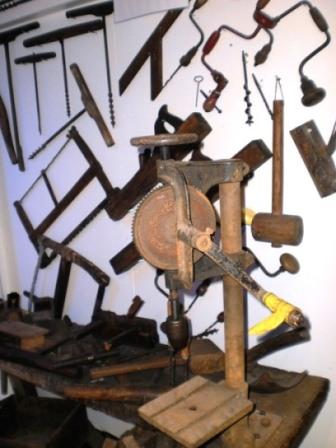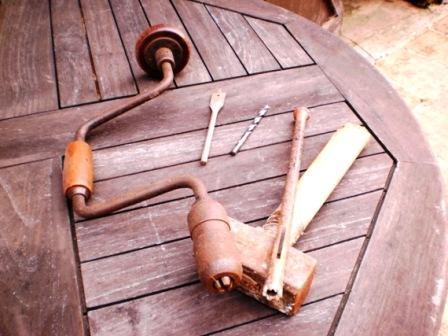Before there were drills and pneumatic hammers there were already holes, and holes bored in wood and stone. How?
 In wood you can pierce a hole with an awl, a solid needle with a sturdy handle.
In wood you can pierce a hole with an awl, a solid needle with a sturdy handle.
If the hole must be larger, you can also burn wood, by making an awl glowing in a fire several times.
There are also augers of which the point has an always widening thread. The last turn is very long, has a sharp edge on the outside and comes in different widths. The top has a T-shape, with which you can rotate the drill powerful in the wood. You can find them sometimes still in toy tool boxes. But it works. This is also called screw auger, gimlet, wimble. A reamer is used to make holes wider.
Efficient is a tool with greater leverage.
You can take a rod, fold it in 90° in five straight pieces of about 15 cm long and 4 (rounded) square corners: part 1 points on a (watch) dial from 12 to 6. Part 2 goes to 9am, part 3 to 6, part 4 to 3 and part 5 further to 6h. Comes on top of a press block (with as little friction as possible, better even some lubrication). Around part 3 is a loose tube (before you fold 4 and 5!), which runs easier. And down a mounting head (chuck) to fix (wood) drills.
Different types of wood borers can be found on the market:
A spiral drill with a sharp focal point and sharp edges (spur point)
A central, pointed tip with two side scraping wings, whether or not with sharp, elongated points (flat wood- or spade bit, and spur point)
Ditto, but the central point is a helix.
An auger has a screw at the bottom in order to center the drill and pull deeper than a cutting head to scratch off material and above that a rod with spiral tube for material removal according to the principle of the Archimedean screw.
It was the hand tool for (ship) carpenters for drilling holes through beams.
Nowadays, a large model auger is used to drill holes for poles in soil. The driven auger “screws“ itself in the bottom, and the soil out of the hole.
 To work in stone, there are steel handles in which drilling bits of various diameters can be put. One side of the handle is hollow. At the end of the cavity, there is a traverse hole straight in the stem: in there you can knock a sharp, angled pen to knock a stuck drill after use back out the holder.
To work in stone, there are steel handles in which drilling bits of various diameters can be put. One side of the handle is hollow. At the end of the cavity, there is a traverse hole straight in the stem: in there you can knock a sharp, angled pen to knock a stuck drill after use back out the holder.
The drills are round, pointed irons with well-balanced in the longitudinal direction along the side manifold 3 long grooves to collect grit. You hammer- drill it in concrete or stone, and it takes every time some material out. Pure hand and manpower so. The crushed gravel is loosened by the grooves and is discharged.
Another type of stone drill or chisel for larger holes consists of a hollow tube, at least for the front section, (about 6 cm), the rear end may be solid. The front is fully serrated like a saw blade or a hole saw. After 15 mm is a longitudinal groove along from which you can remove hammered grit. It works, but slower than Power Tools.
As plug we used pieces of wood with a knife more or less cut in shape, which then were rammed into the hole. If plastic plugs are loose or rotate, I still hit it with wooden skewers. You can fix all stuck with it, even in a crumbled hole.
“Why have you drilled two holes in the wall?”“The first hole was too small."
